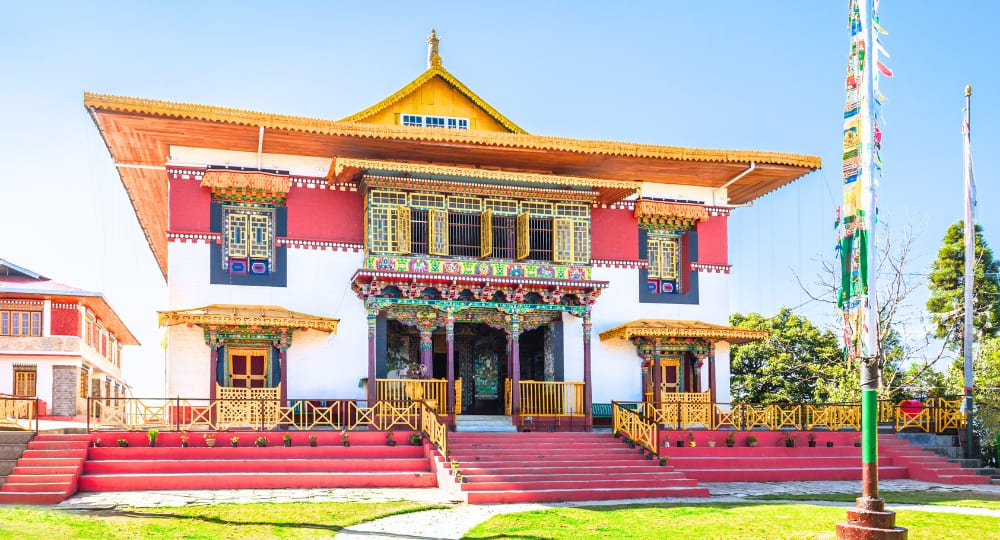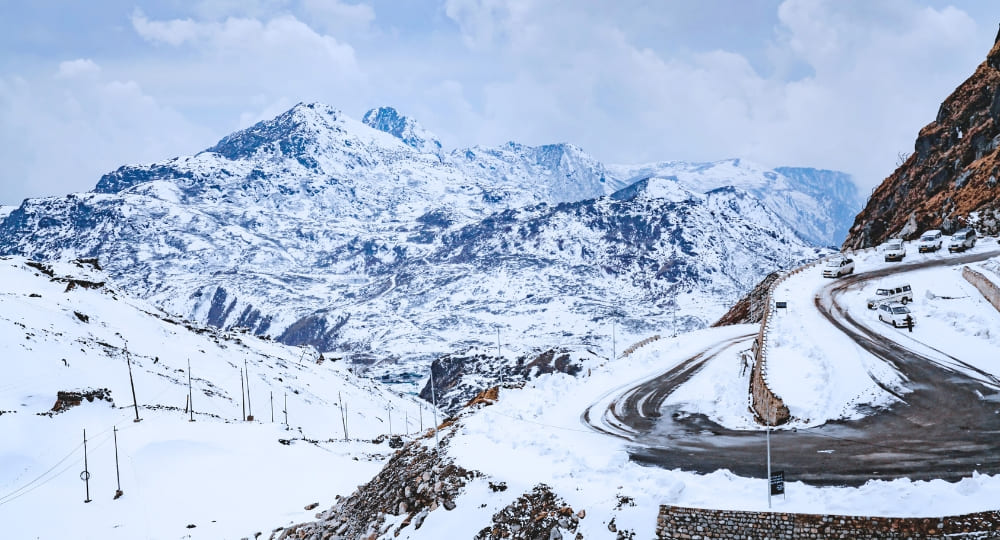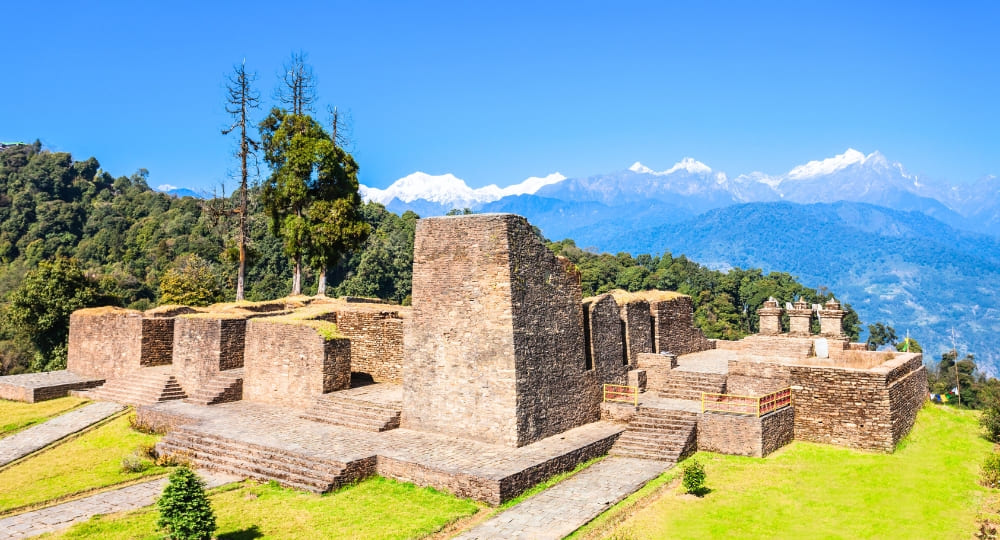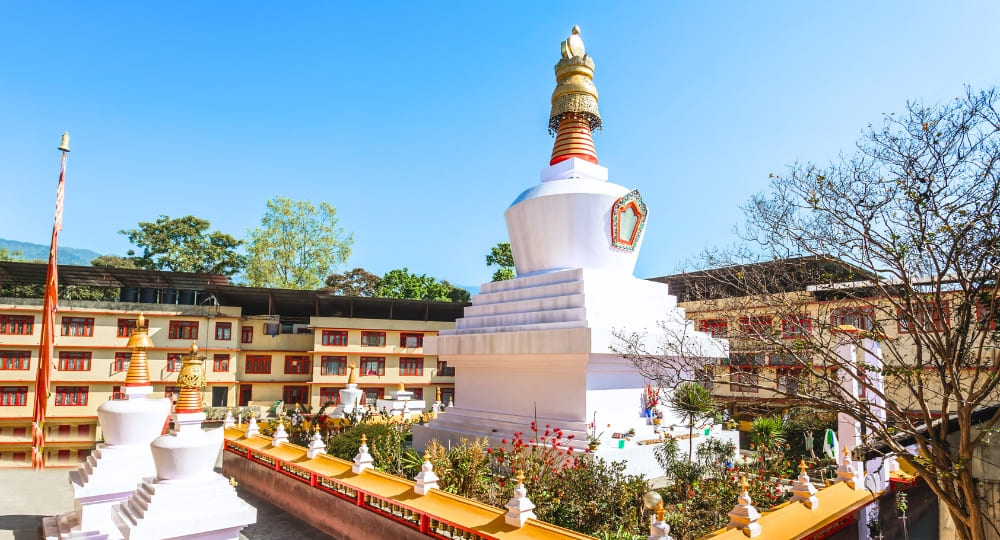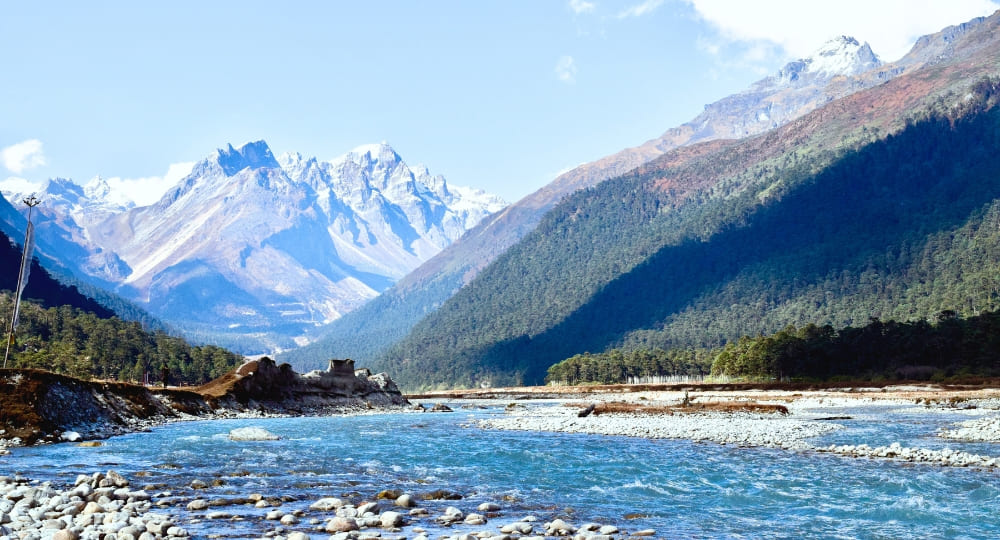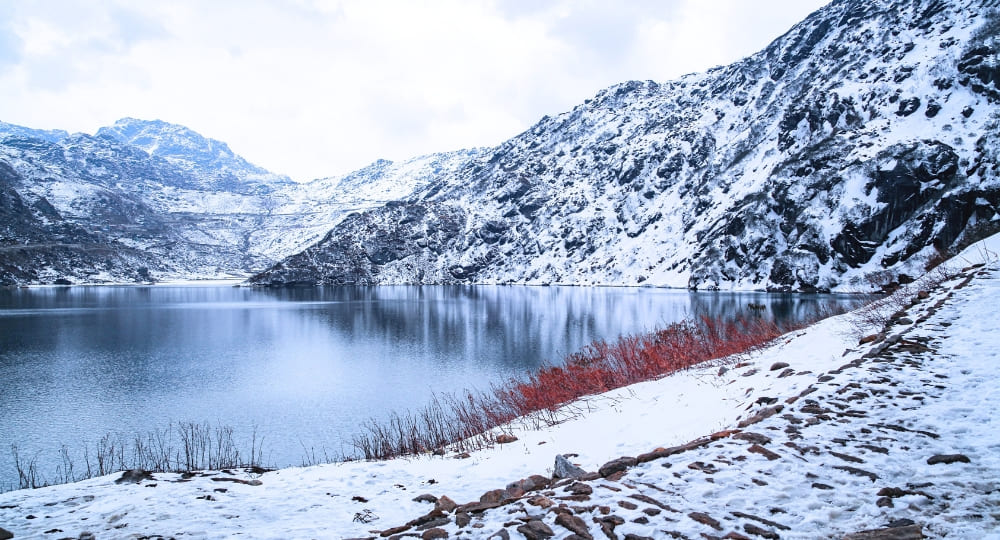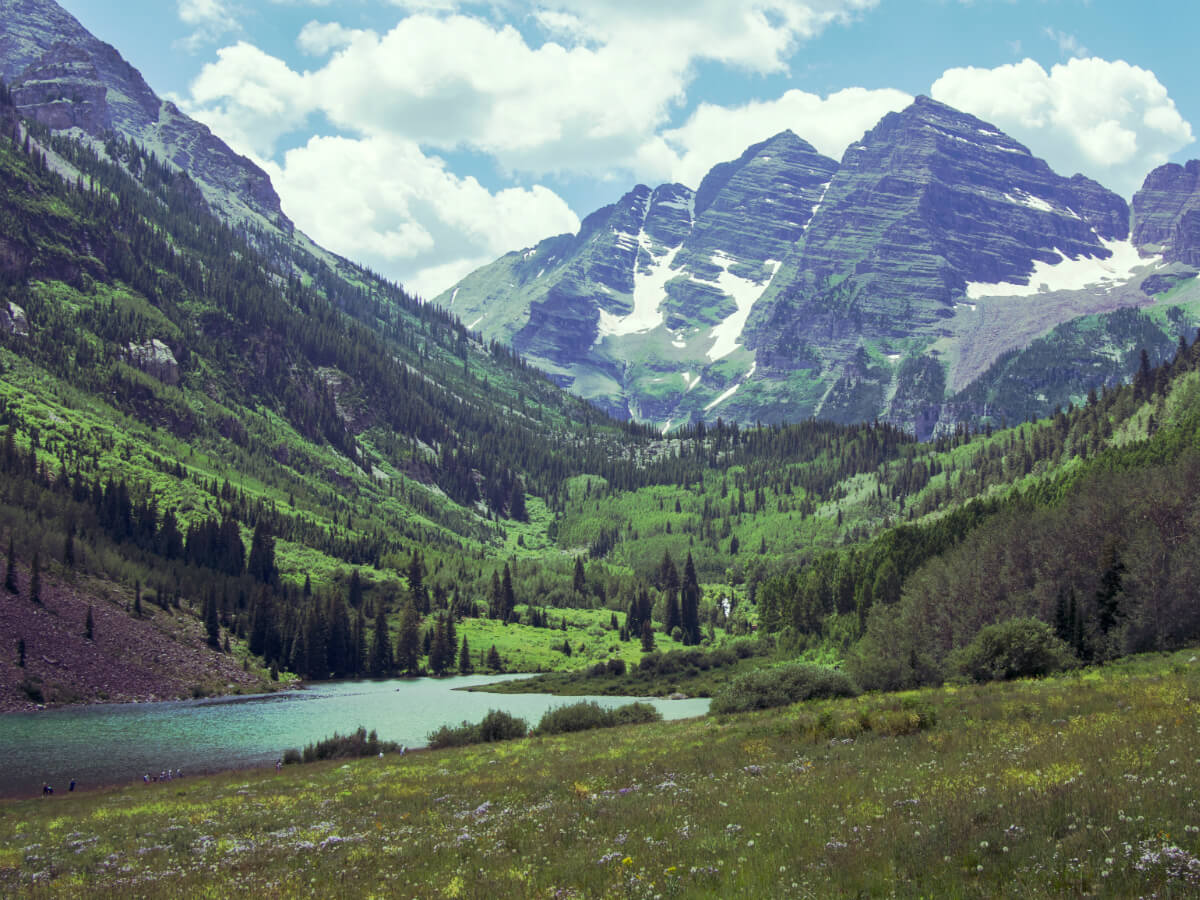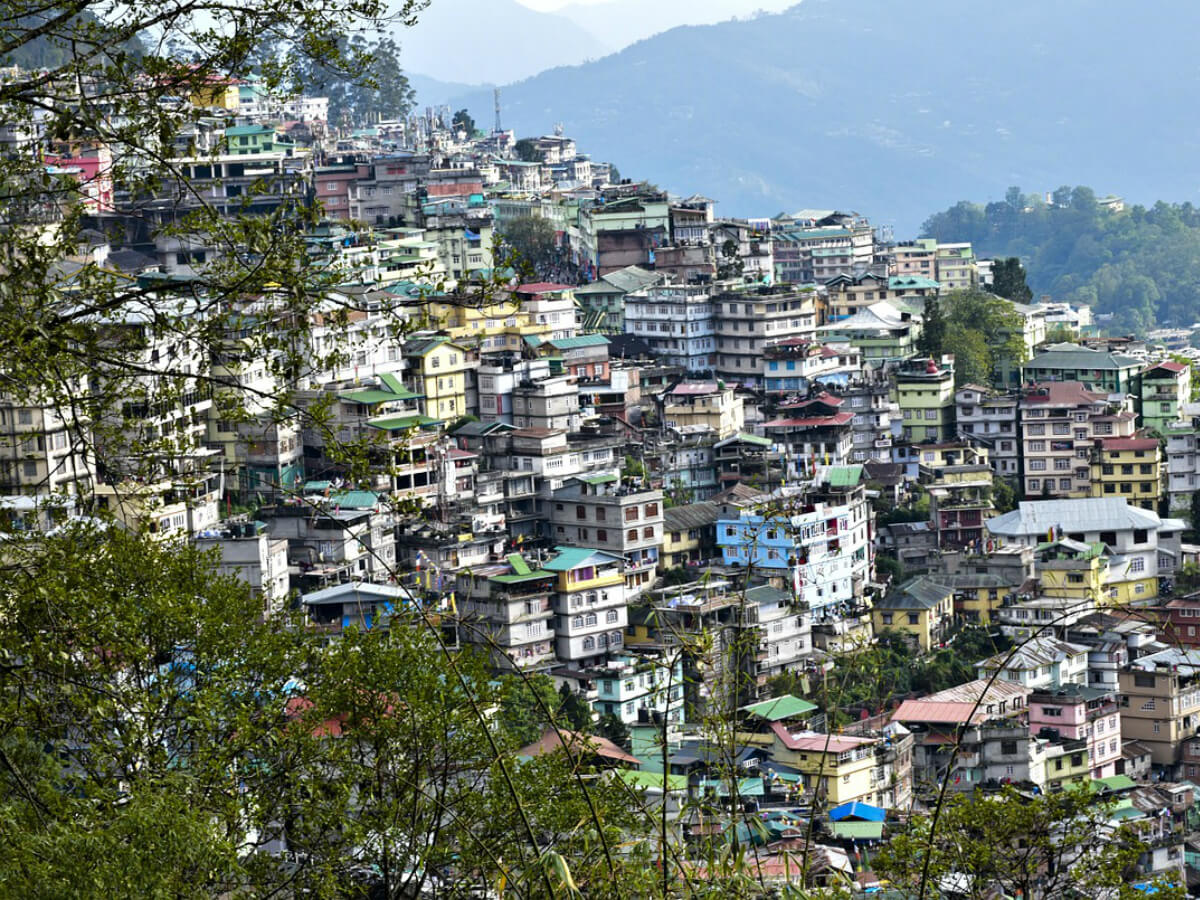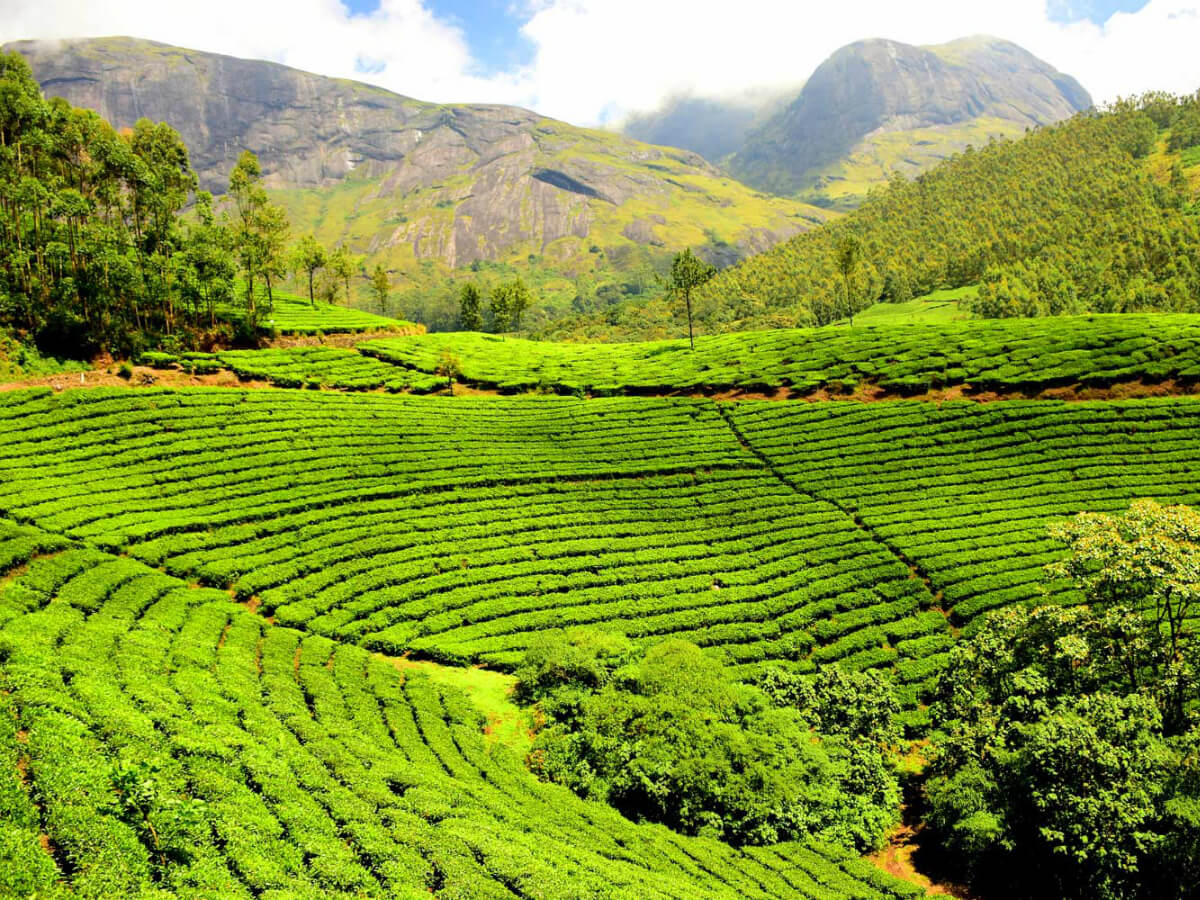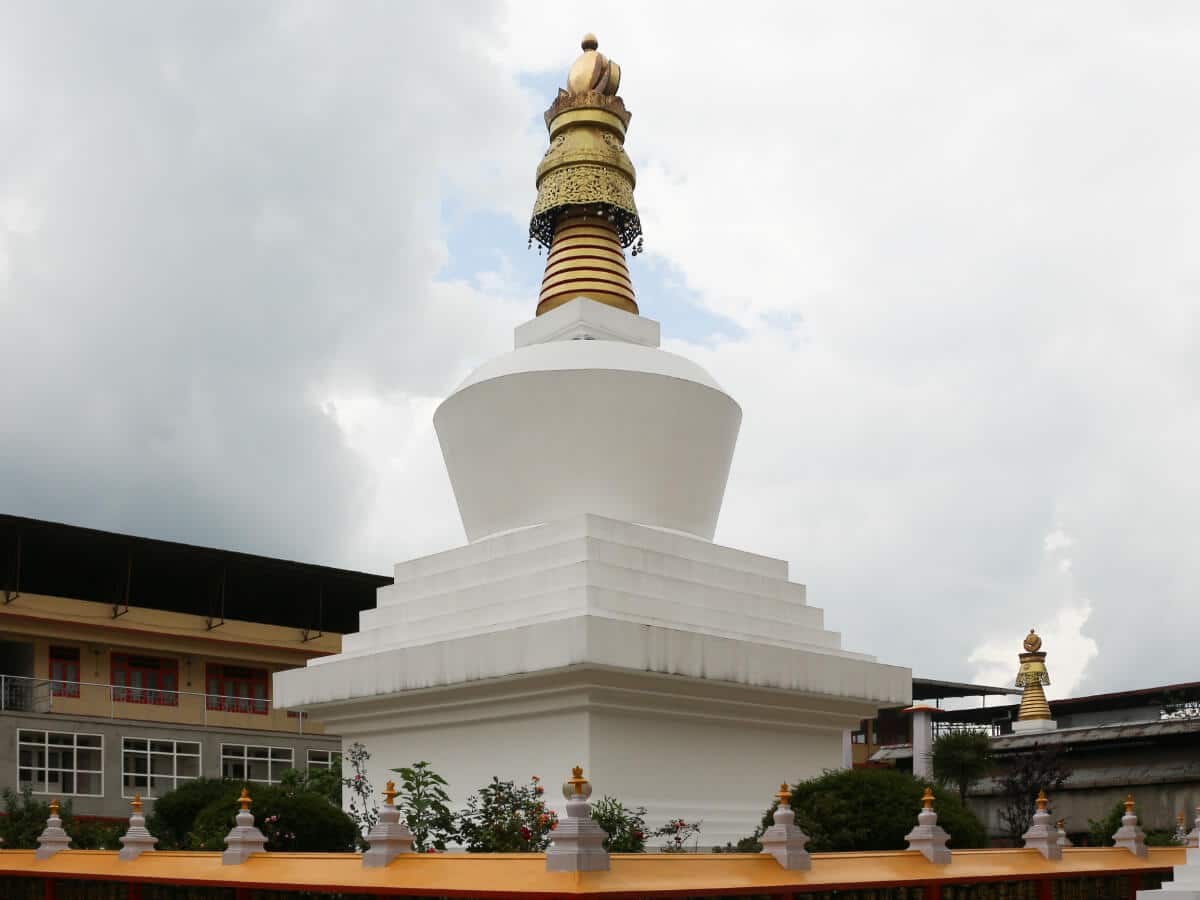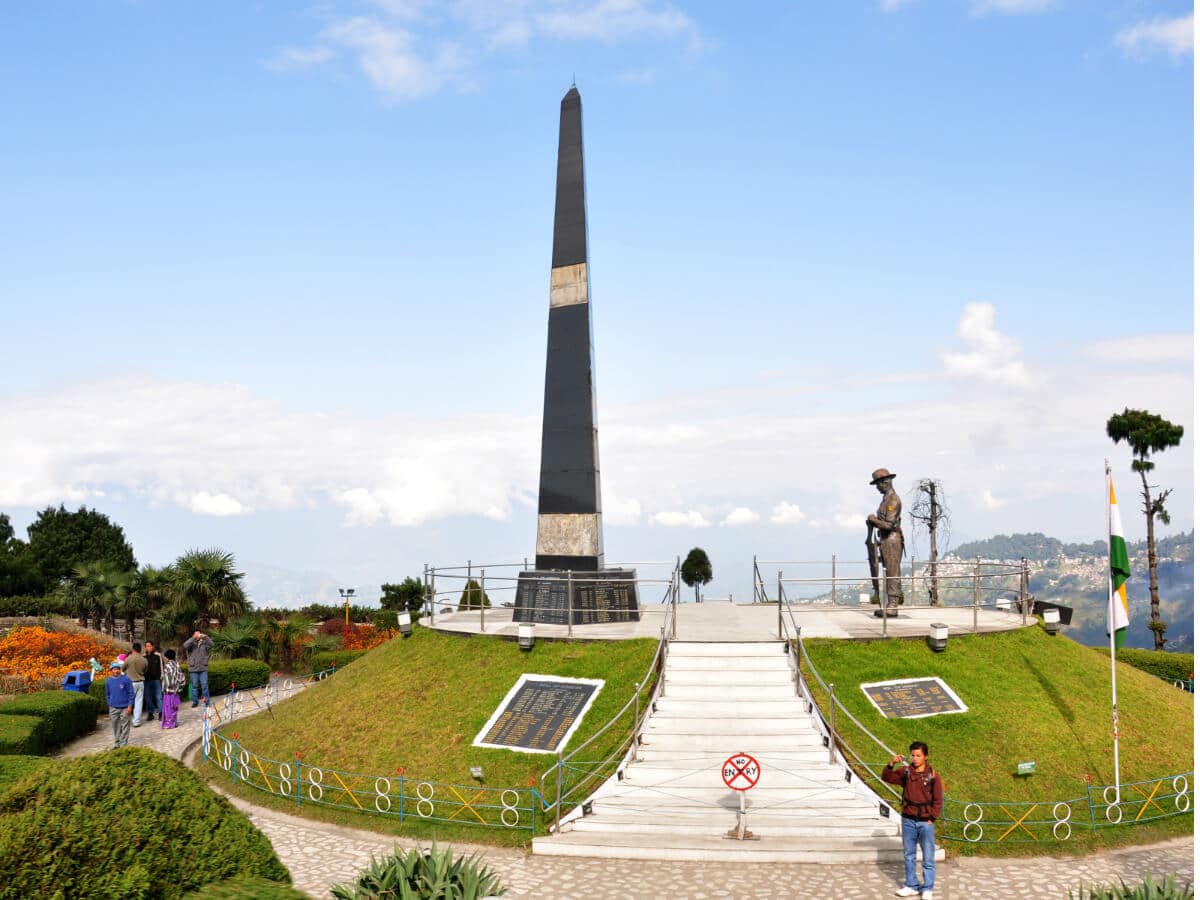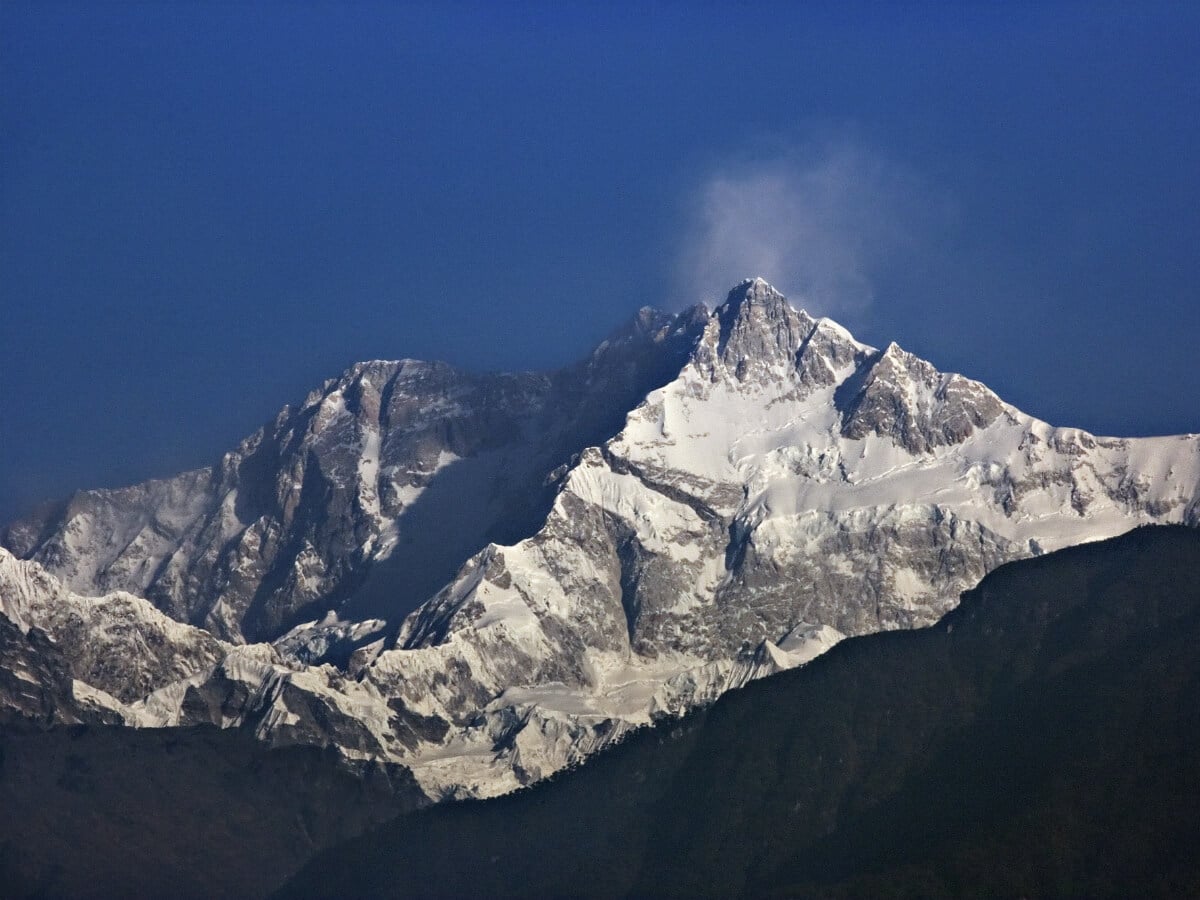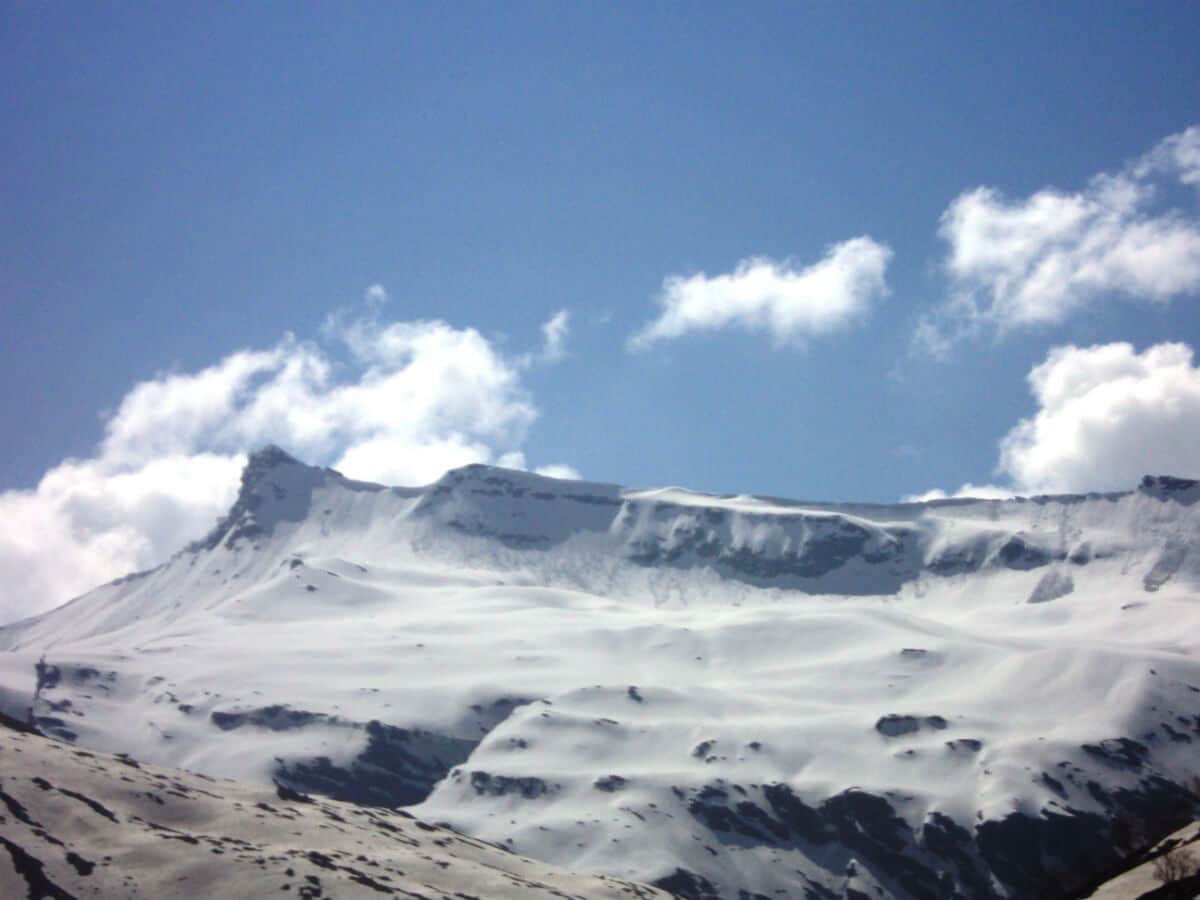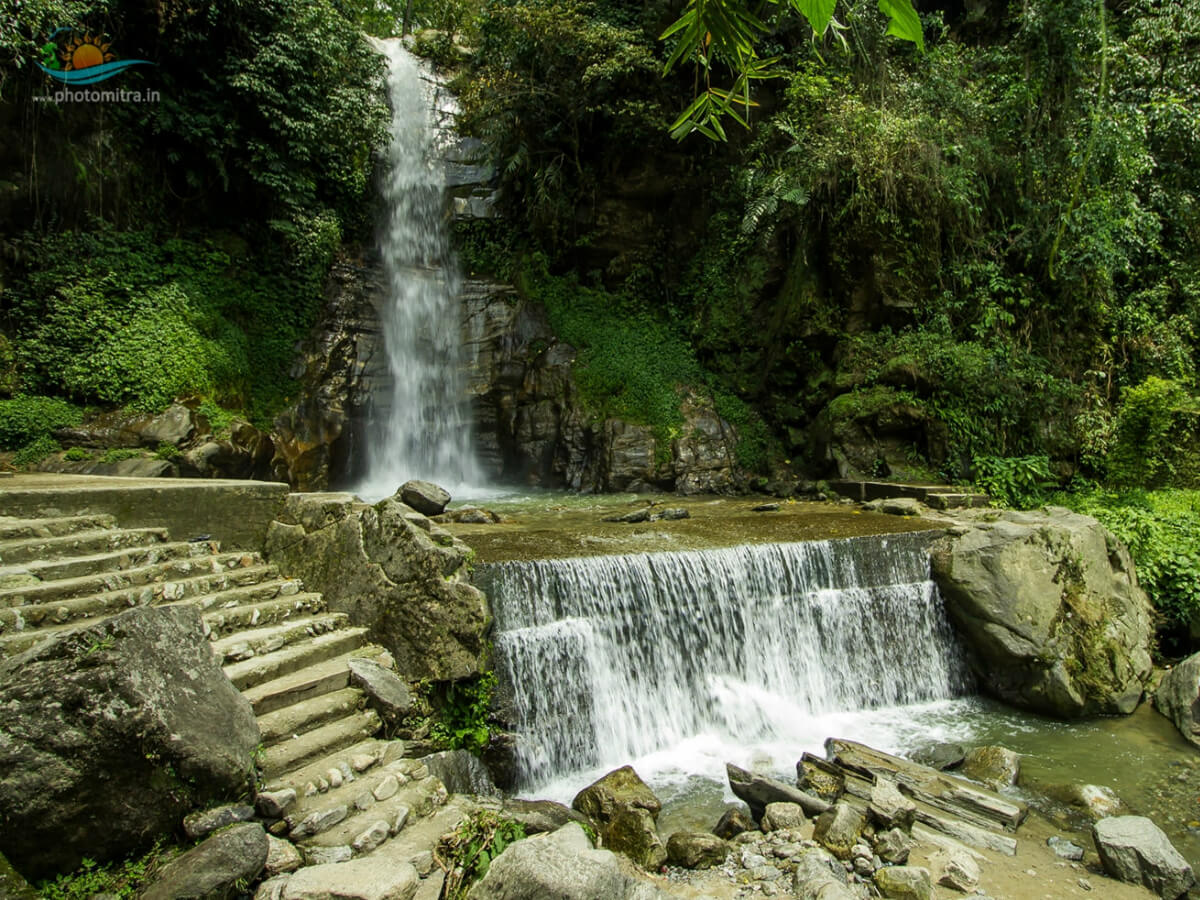Tour Packages
Sikkim Tour Packages
SUPER DEAL PRICE
STARTS FROM
per person on twin sharing
Do Drul Chorten is a famous Buddhist stupa in Gangtok.

Yumthang Valley is known as the Valley of Flowers.
Gurudongmar Lake is one of the world’s highest lakes.

Old Silk Route offers views of Mount Kangchenjunga.

Tsomgo Lake is Sikkim’s seasonal colour-changing lake.

Rinchenpong is a serene village in West Sikkim.
Sikkim - Overview
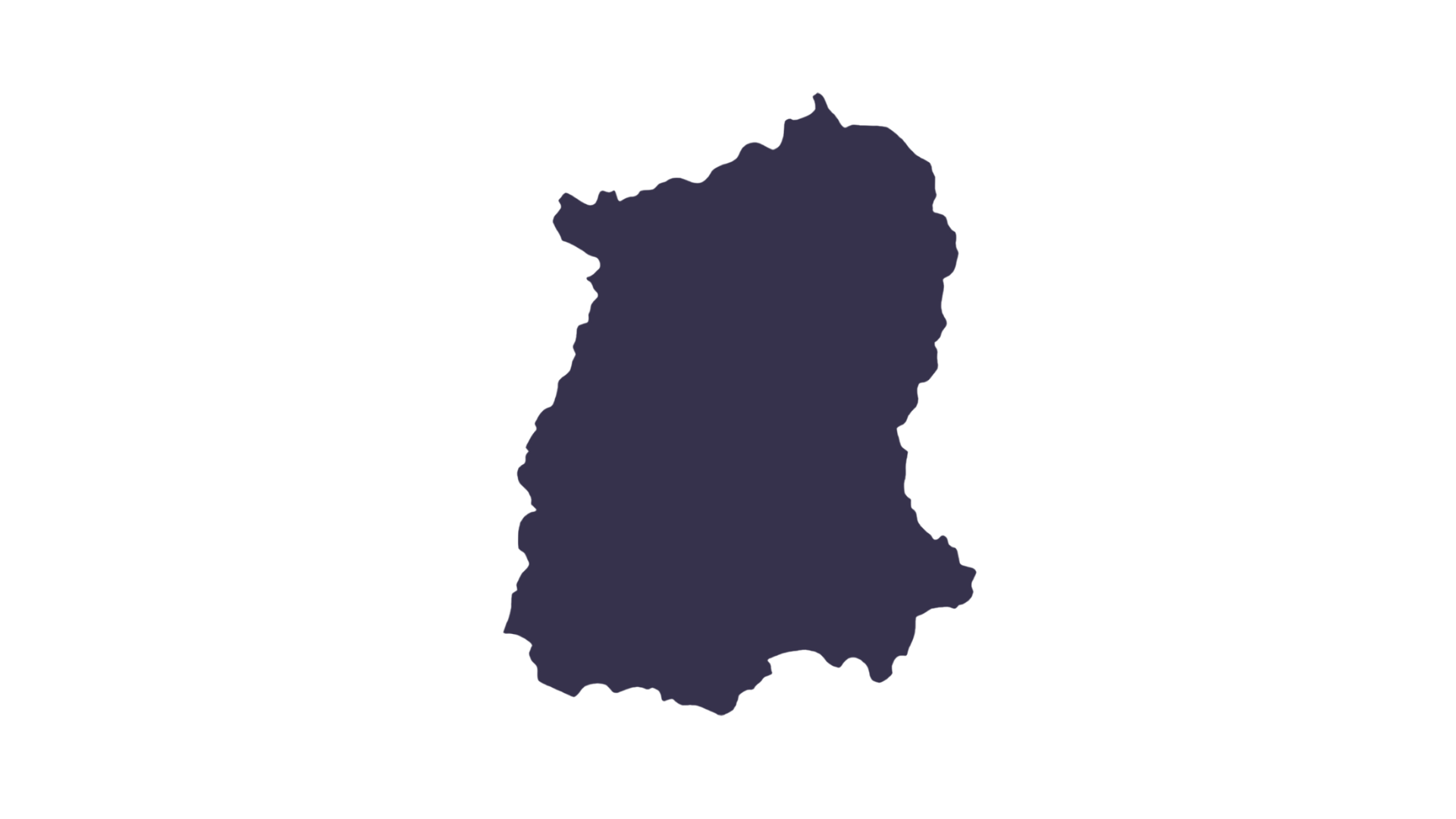
By Purpose
Couples
For Newlywed Vacations
Family
For Family Vacations
Top Attractions
Tsomgo Lake
Nathula Pass
Rumtek Monastery
Do Drul Chorten
Rabdentse Ruins
Hanuman Tok
Yumthang Valley
Gurudongmar Lake
Temi Tea Garden
Rinchenpong
Pemayangtse Monastery
Khangchendzonga National Park
Everything You Need to Know About Sikkim
Located in the northeastern part of India is the state of Sikkim, which is often called the ‘brother state’ of the ‘Seven Sisters of India’. It’s also referred to as the ‘eight state’ because of its geographical location and the vital cultural relationship it has with the other states in Northeast India. The natural landscapes of the state include everything, right from rivers, waterfalls, and valleys, to mountains and the spellbinding view of the Kangchenjunga. Whether you’re having momos at a quaint eatery or going for yak rides near Tsomgo Lake, the reasons to book our Sikkim tour packages truly are endless. Despite being one of the smallest states in the country, Sikkim provides an invigorating and memorable experience to tourists everywhere. Let’s do a deep dive into the art, history, culture, cuisine, shopping scene, and tourist attractions of Sikkim so you can know why you must grab our Sikkim tour packages right away.
Table of Content:
- About Sikkim
- Tidbits
- Essential Tips To Know Before Travelling To Sikkim
- Our Best Budget Sikkim Tour Packages
- Sikkim At A Glance
- Top Reasons To Visit Sikkim
- Best Time To Visit Sikkim
- Top Cities And Towns To Visit In Sikkim
- Top Things To Do In Sikkim
- Shopping In Sikkim
- Dos and Don’ts For Indian Travellers
- Foods To Try Out In Sikkim
- Art And Culture In Sikkim
About Sikkim
History
Not much has been documented regarding Sikkim’s history before the 17th century. The name of the state has been derived from the Limbu words ‘su’ and ‘khyim’, wherein ‘su’ means ‘new’ and khyim’ means ‘house’. The Namgyal dynasty, also known as the Chogyal dynasty, ruled the Kingdom of Sikkim from 1642 to 1975. Sikkim saw the formation of political parties for the first time following India’s independence from the British in 1947. They aimed to create a popularly elected government and make Sikkim a part of India. The chogyal (monarch of Sikkim), along with his followers, resisted all of these demands. Sikkim became an Indian protectorate through the Indo-Sikkimese Treaty of 1950, thereby making India responsible for Sikkim’s strategic communications, defence, and external relations. In 1974, Sikkim’s National Assembly approved the constitution prepared by India. A special referendum was held in 1975, where over 97% of the Sikkimese electorate voted in favour of Sikkim’s merger with India. In May 1975, Sikkim was declared the 22nd state of India.
Economy
The economy of Sikkim is mainly dependent on agriculture. Over half the working population of the state is engaged in the agricultural sector. Some of the crops grown in Sikkim are rice, corn, barley, wheat, and buckwheat. The other items grown in Sikkim include tea, fruits, vegetables, potatoes, ginger, and beans. Sikkim is one of the biggest producers of cardamom not only in India, but also around the world. The farmers in Sikkim raise livestock, such as goats, sheep, pigs, poultry, and cattle.
Tidbits
- During the Swachh Survekshan Gramin 2016, Sikkim was declared the cleanest state in India.
- Sikkim is the least populated state in India.
- Kangchenjunga, which is the world’s third-highest peak, is situated on the border between Sikkim and Nepal.
- Sikkim is one of the largest cardamom-producing states in India.
- Dalle khursani, which is one of the hottest chillies in the world, is grown in Sikkim.
- Sikkim became the world’s first fully organic state in 2016.
- Sikkim shares its borders with three countries, namely Nepal, Bhutan, and China.
- 82.31% of Sikkim’s geographical area is covered by forests.
- The Teesta River originates in Sikkim.
- The Khangchendzonga National Park in Sikkim is India’s first Mixed World Heritage Site as declared by UNESCO.
- The MG Marg in Sikkim is the country’s first litter and spit-free zone.
- The Namgyal Research Institute of Tibetology (NIT) in Sikkim is among the most respected institutions around the globe for the study of Tibetan culture and Buddhism.
- The biggest monastery in Sikkim is Rumtek Monastery.
- The Tsomgo Lake in Sikkim changes colours with each season.
- The International Flower Show in Sikkim takes place each year in May to celebrate the state’s floral diversity.
Essential Tips To Know Before Travelling To Sikkim
- The mountainous and winding roads of Sikkim can often cause motion sickness, so keep your medicines around accordingly.
- Make sure to get your permits for the restricted areas beforehand.
- The regions of higher altitude in Sikkim can induce altitude sickness. Therefore, carry the necessary medicines with you.
- Since you might engage in outdoor adventures in Sikkim, remember to carry comfortable footwear.
- The nearest airport to Sikkim is the Pakyong Airport. You can also fly to the Bagdogra Airport in Siliguri, which is about 125 km away from Gangtok by road.
- The railway station located nearest to Gangtok is the New Jalpaiguri (NJP) railway station.
- Don’t drink tap water in Sikkim during your trip. Always carry bottled water, even when you’re out sightseeing.
Our Best Budget Sikkim Tour Packages
| Sikkim Tour Packages | Duration | Highlights |
| Amazing Gangtok Darjeeling Tour | 3 Nights 4 Days | Hanuman Tok, Enchey Monastery, Do Drul Chorten, Tiger Hill, Batasia Loop, Peace Pagoda |
| Best of Eastern Hill Tour | 4 Nights 5 Days | Rumtek Dharma Chakra Centre, Hanuman Tok, Ban Jhakri Falls, Enchey Monastery, Do Drul Chorten, Tiger Hill, Batasia Loop, Peace Pagoda |
| Discover Darjeeling and Gangtok Tour | 4 Nights 5 Days | Hanuman Tok, Ganesh Tok, Ban Jhakri Falls, Enchey Monastery, Do Drul Chorten, Delo Park, Mangal Dham Temple |
| Eastern Triangle Tour Package | 6 Nights 7 Days | Hanuman Tok, Ganesh Tok, Ban Jhakri Falls, Enchey Monastery, Do Drul Chorten, Delo Park, Mangal Dham Temple, Ghoom Monastery, Batasia Loop |
| Himalayan Golden Triangle Holiday Package | 6 Nights 7 Days | Ganesh Tok, Enchey Monastery, Do Drul Chorten, Delo Park, Mangal Dham Temple, Ghoom Monastery, Batasia Loop, Peace Pagoda |
| Himalayan Tranquility | 5 Nights 6 Days | Sikkim Himalayan Zoological Park, Tsomgo Lake, Do Drul Chorten, Ganesh Tok, Enchey Monastery, Delo Park, Kalimpong Science Centre, Mangal Dham Temple, Ghoom Monastery, Batasia Loop, Peace Pagoda |
| Honeymoon in Himalayas | 4 Nights 5 Days | Ban Jhakri Falls, Tsomgo Lake, Do Drul Chorten, Ghoom Monastery, Batasia Loop |
| Jewels of North East Package | 4 Nights 5 Days | Hanuman Tok, Sikkim Himalayan Zoological Park, Ganesh Tok, Enchey Monastery, Dubdi Monastery, Kanchenjunga Falls, Khecheopalri Lake |
| Unspoiled Hills | 5 Nights 6 Days | Tsomgo Lake, Hanuman Tok, Sikkim Himalayan Zoological Park, Ganesh Tok, Ghoom Monastery, Batasia Loop |
Sikkim At A Glance
| Category | Details |
| State | Sikkim |
| Currency | The Indian Rupee (INR) |
| Capital City | Gangtok |
| High season | March to June |
| State Flower | Noble orchid |
| Standard Voltage | 230 volts |
| State Animal | Red panda |
| Languages | Official: Nepali and Sikkimese ; unofficial: Lepcha and Limbu |
| Famous Tourist Attractions | Tsomgo Lake, Nathula Pass, Rumtek Monastery, Khangchendzonga National Park, Pemayangtse Monastery, Do Drul Chorten, Rabdentse Ruins, Hanuman Tok, Yumthang Valley |
| Things To Do | Trekking, river rafting, mountaineering, yak rides |
| Famous Food | Momos, thukpa, phagshapa, sel roti, gundruk, sinki, sha phaley |
| Places To Visit | Gangtok, Lachung, Pelling, Lachen, Ravangla |
| Souvenirs To Buy | Tibetan carpets, thangkas, prayer flags, Sikkimese tea, choktses, masks |
Top Reasons To Visit Sikkim
Here are some of the reasons why you should book our Sikkim tour packages right away:
Mesmerising Natural Landscapes
The natural beauty of Sikkim will leave you spellbound. From mountains and rivers to forests, valleys, and waterfalls, Sikkim has a wide array of natural landscapes that welcome tourists. It’s home to Kanchenjunga, the third-highest mountain in the world. There is the awe-inspiring view of the Tsomgo Lake, a glacial lake which changes colours every season and is frozen during the winter months. Enjoy the unique sight of the Seven Sisters Waterfall, where seven distinct waterfalls cascade down the cliffs, creating a visual spectacle. You absolutely must visit the Yumthang Valley, which is also known as the ‘Valley of Flowers’ and is home to approximately 40 species of rhododendrons.
Delicious Food
The cuisine of Sikkim is inspired by numerous cuisines, such as Nepali and Tibetan, along with the native Sikkimese culinary traditions. You will find the presence of rice, barley, and maize in plenty in Sikkimese food. Interesting elements such as yak cheese or chhurpi can also be found in the region’s cuisine. Meat lovers can relish the many chicken and pork dishes whipped up in Sikkim. Along with locally grown vegetables, you will notice that the locals often season their food with ginger, garlic, and green chillies. Be it a plate of succulent momos or a bowl of comforting thukpa, almost every dish in Sikkim feels like a hug to the soul.
Rich Cultural Heritage And Peaceful Monasteries
The rich cultural heritage of Sikkim is evident through its cuisine, festivals, and the presence of diverse communities. The Lepchas, Bhutias, and Nepalis are the main communities that coexist harmoniously in Sikkim. Every festival in the state is celebrated with pomp and glory, such as Saga Dawa, Maghe Sankranti, Sonam Lochar, and Losar. The cultural and spiritual significance of Sikkim is also due to the many monasteries the state is home to. Sikkim is known to have more than 200 monasteries, which are also known as ‘gompas’, many of which you can visit with GT Holidays’ Sikkim tour packages.
Haven For Adventure Enthusiasts
With both beaches and mountains as its background, Sikkim is a haven for adventure enthusiasts. Whether you want to go river rafting in the Teesta River or opt for one of the many treks offered in Sikkim, there are endless outdoor adventures to choose from. Some of the other thrilling activities you can try out with our Sikkim tour packages include paragliding, yak rides, and mountaineering.
Diverse Flora And Fauna
Sikkim has a vast variety of flora and fauna. The Khangchendzonga National Park in Sikkim has almost half of the country’s bird diversity. It is also home to a rich diversity of rhododendrons, orchids, and wild trees. Did you know that the Khangchendzonga National Park also houses one-third of India’s flowering plants? The other places where the flora of Sikkim shines bright include the Yumthang Valley and Barsey Rhododendron Sanctuary. Sikkim has more than 150 species of mammals, including red pandas, snow leopards, musk deer, barking deer, the Asiatic black bear, and the Himalayan tahr. If you’re travelling with kids, especially, make sure to take them to the Khangchendzonga National Park, Fambong Lho Wildlife Sanctuary, Pangolakha Wildlife Sanctuary, and Maenam Wildlife Sanctuary.
Best Time To Visit Sikkim
Due to the diverse geography of Sikkim, the state enjoys an eclectic variety of climatic conditions, including tropical, alpine, and temperate. While the southern areas have a subtropical climate, the northern regions have an alpine climate, which means cold deserts and a snowy environment. It’s known to have one of the most humid climates in the entire Himalayan range. This is because it’s located close to the Bay of Bengal and is directly exposed to the moist monsoon winds. The peak tourist season in Sikkim is usually between March and May and September and November. The off-season is usually between July and September. Let’s take a look at what each season in Sikkim brings about so you can accordingly decide when to book our Sikkim tour packages.
Sikkim In Summer (April To June)
During the summer season, the range of temperature in Sikkim is between 5 degrees Celsius and 25 degrees Celsius. This is the ideal time to go trekking, and it’s also the perfect season to try out river rafting in the Teesta River. Although the temperature during the daytime remains warm and comfortable, it can get chilly during the nights and evenings. Therefore, remember to pack light layers and a jacket if you visit at this time with our Sikkim tour packages. Although Sikkim experiences dry summers, you must stay prepared for sudden changes in weather, which means occasional rainfall as well. This is especially common in areas of higher altitude. The festivals that take place in Sikkim during this season include the Saga Dawa festival and the renowned International Flower Festival.
Sikkim In Monsoon (July To September)
During the monsoon season in Sikkim, the temperature can go as low as 4 degrees Celsius, and the highest temperature is usually 15 degrees Celsius. The state receives somewhere between moderate and heavy rainfall, and the temperature drops at this time. Although the rains make the landscapes bloom with lush greenery, there are issues such as road closures and landslides that one can face. Due to this reason, this is the off-season in September and the region isn’t too crowded. If you want affordable accommodation options, then this is the right season to book our Sikkim tour packages. Make sure to pack all the necessary rain gear, including umbrellas, sturdy boots, and waterproof clothes.
Sikkim In Autumn (September To October)
In Sikkim, September is the month which falls somewhere between monsoon and autumn. While the first half of the month experiences the monsoon season, it slowly begins to transition into autumn towards the end of the month. Fall is in full swing in Sikkim during the month of October. Along with vibrant foliage, this month offers picturesque views of the mountain ranges, particularly the Kangchenjunga. The temperature during the autumn months remains between 11 degrees Celsius and 20 degrees Celsius. The festivals that occur at this time include the Maniram Bhanjyang Tourism Festival, Diwali, and Dussehra.
Sikkim In Winter (November To March)
During the winter season, the temperature in Sikkim can often drop to -5 degrees Celsius in areas of higher altitude. In the other areas of the state, the temperature usually remains between 4 degrees Celsius to 7 degrees Celsius. If a snow-covered landscape is what you wish to enjoy, then this is the right time to visit the state with GT Holidays’ Sikkim tour packages. This is also the best season to explore some of the most popular tourist attractions, such as the Tsomgo Lake, Nathula Pass, and Yumthang Valley. Pack plenty of warm clothes for this season, such as jackets, gloves, scarves, sturdy boots, and thermal wear. Heavy snowfall can cause road closures, especially in remote regions. Check the weather forecast and plan your itinerary accordingly. The Red Panda Winter Festival takes place in Sikkim at this time.
Top Cities And Towns To Visit In Sikkim
Gangtok
Gangtok is the capital of Sikkim. The minute you enter the city, you are embraced by its peaceful atmosphere, which includes the sight of monasteries and prayer flags. Filled with bustling markets, tourists can enjoy a gala time shopping in Gangtok at places like MG Marg and Lal Bazaar. You must visit the numerous monasteries Gangtok has, including Rumtek Monastery, Phodong Monastery, and Enchey Monastery. Gangtok is a conglomeration of rich culture and traditions, which is also evident through its cuisine, whether it’s gundruk, momos, or thukpa. Visit the spectacle that is Tsomgo Lake and take a yak ride near this gorgeous glacial lake.
Lachung
Lachung is a small town in North Sikkim, which is situated at a height of approximately 8,858 feet. Located about 116 km away from Gangtok, the British explorer named Joseph Dalton Hooker referred to it as the most picturesque village of Sikkim in his work, Himalayan Journals. This quaint hill station is engulfed by snow-covered mountains, peaceful streams, mesmerising waterfalls, and apple orchards.
Pelling
Pelling is a town situated in West Sikkim. Its popularity has grown so much over the years that it is now considered the second-most famous destination in Sikkim after Gangtok. Perched at a height of 6,800 feet, Pelling has several adventures for tourists to embark upon, suck as trekking, paragliding, and mountain biking. When you visit Pelling with our Sikkim tour packages, remember to explore the Pemayangtse Monastery, Rabdentse Ruins, and Khecheopalri Lake.
Lachen
Lachen is a town located in Sikkim’s northern district. It is perched at a height of 2,750 metres and serves as the base for several popular treks, including the Green Lake Trek and Kanchenjunga National Park Trek. Some of the tourist attractions in and near Lachen that you must visit are Gurudongmar Lake, Thangu Valley, and Lachen Monastery.
Ravangla
Ravangla is a town located in the southern region of Sikkim. Settled between Pelling and Gangtok, the town of Ravangla is situated at a height of about 7,000 feet above sea level. One of the most famous tourist attractions in Ravangla is the Buddha Park (also known as Tathagata Tsal), which has a massive 130-foot-tall statue of the Buddha. Some of the other places you should visit are the Ralang Monastery, Ralong Hot Springs, Temi Tea Estate, and Bon Monastery.
Top Things To Do In Sikkim
Sikkim has numerous tourist attractions for you to visit and plenty of thrilling adventures for you to participate in, all of which you can do with our Sikkim tour packages. Listed below are some of those places and activities for you to check out:
Things To Do As A Family
Tsomgo Lake
Tsomgo Lake, which is also known as Tsongmo Lake or Changu Lake, is situated approximately 40 km from Gangtok. This glacial lake is perched at an elevation of 12,313 feet above sea level. Legend says that the Tsomgo Lake was formed by the tears of deities who cried upon seeing the distress of the villagers, which is why it’s highly respected by the locals. As the season change, the colours of the lake change as well, and it becomes frozen during the winter months.
Nathula Pass
Nathula Pass is a mountain pass situated in Sikkim’s northern region, about 56 km from Gangtok. It was once a part of the historic Silk Route. Located at a height of about 14,140 feet, it’s a vital landmark on the Indo-China border. The name of Nathula Pass is derived from the words ‘nathu’, meaning ‘listening ears’, and ‘la’, meaning ‘pass’. Since it’s a politically sensitive area, the mountain pass is open to visitors only five days a week, from Wednesday to Sunday. One of the most significant reasons to visit Nathula Pass is that you get the opportunity to see the soldiers who patrol and guard the border with China.
Rumtek Monastery
The Rumtek Monastery is located approximately 23 km from Gangtok. Serving as the seat of His Holiness, the Gyalwa Karmapa of the Kagyu sect of Tibetan Buddhism, it’s a replica of the Tsurphu Monastery in Tibet. Also known as the Dharma Chakra Centre, it’s situated at a height of about 1,500 metres and is the largest monastery in Sikkim. When you make your way to the monastery, you will witness quaint Sikkimese villages and expansive paddy fields. Paintings and murals of the four deities, namely Virupaksha, Virudaka, Dritarashtra and Vaishravana, decorate the entrance of the monastery. These deities are said to be the guardians of the Rumtek Monastery.
Khangchendzonga National Park
The Khangchendzonga National Park, or Kanchenjunga National Park, is a protected area spread over an area of over 1,784 sq km. It was recognised by UNESCO as India’s first ‘Mixed Heritage’ site and was declared a UNESCO World Heritage Site in 2016. The park is home to a diverse range of flora and fauna and is known to house close to half of the country’s bird diversity and one-third of India’s flowering plants. The park is renowned for having one of the most extensive stunted forest zones in India’s Himalayan region. The best time to visit the Khangchendzonga National Park is between March and May, and September and November. Some of the wildlife you will come across at this UNESCO site are snow leopards, red pandas, musk deer, the Himalayan black bear, and blue sheep.
Pemayangtse Monastery
The Pemayangtse Monastery is located near the town of Pelling in Sikkim. Founded between 1650 and 1651 AD by Lhatsun Chhenpo, it is believed to be the second-oldest monastery in Sikkim. The name of the monastery translates to ‘perfect sublime lotus’. It originally started out as a small shrine known as ‘Tsangkhang’, and was shifted to its current location in 1705. The monastery was established by Chogyal Chakdor Namgyal and Khenchen Rolpai Dorjee in honour of one of the founding fathers of Tibetan Buddhism, Guru Padmasambhava. There is a small religious structure located at the monastery’s entrance. Within this structure is a statue of Dorje Phagmo, which was gifted by Terton Terdag Lingpa of Tibet, Chogyal Gyurmed Namgyal, after the latter married his daughter.
Do Drul Chorten
Do Drul Chorten is an ancient Buddhist stupa located in Gangtok near the Namgyal Institute of Tibetology. It was built in 1946 by Trulshik Rinpoche, who was a teacher of the 14th Dalai Lama. The main stupa is surrounded by 108 prayer wheels. The central dome of the stupa is embellished with sacred symbols and intricate carvings, all of which reflect the rich spiritual heritage of Tibetan Buddhism. Within this spiritual gem are relics, holy books, and other objects of religious significance.
Buddha Park (Tathagata Tsal)
The Buddha Park, also known as Tathagata Tsal, is located in the town of Ravangla in Sikkim. It was constructed between 2006 and 2013 to honour the 2550th birth anniversary of Lord Gautam Buddha. The centrepiece of Buddha Park is an awe-inspiring 130-foot-tall statue of the Buddha. The 14th Dalai Lama consecrated the statue in March 2013. The Cho-Dzo Lake is situated within the park complex.
Rabdentse Ruins
From 1670 to 1814, the Rabdentse Ruins served as the second capital of what used to be the Kingdom of Sikkim. Often referred to as the ‘Machu Picchu of India’, it is recognised as a heritage monument by the Archaeological Survey of India (ASI). It was founded in 1670 by Tensung Namgyal, who was the second Chogyal or monarch of Sikkim. This historical treasure is currently a part of a Buddhist religious pilgrimage circuit, with the first one being the Dubdi Monastery. The other sacred sites that are a part of this circuit are the Pemayangtse Monastery, Tashiding Monastery, and Norbugang Chorten. The ruins are home to a white marble slab where the locals often offer prayers. Legend says that this 7-foot-long slab was carried all the way to the top of the hill by just one person.
Hanuman Tok
Dedicated to Lord Hanuman, the temple known as Hanuman Tok is situated about 11 km from Gangtok. It was established by a bureaucrat named Appaji Pant. Later, the area was taken over by the Indian Army in 1968. Today, the temple continues to be maintained by officers of the Indian Army and is well-known for its serene ambience and cleanliness. Perched at a height of 2,194 metres, devotees flock to the temple not only for its spiritual value, but also to experience the outstanding view of the Kanchenjunga.
Khecheopalri Lake
The Khecheopalri Lake is situated near Pelling and is revered as a sacred site by Hindus and Buddhists. Located at a height of 5,600 feet, it’s thought to be 3,500 years old. The lake was originally known as ‘Kha-Chot-Palri’, which translates to ‘the heavenly abode of Padmasambhava’, who is often referred to as the second Buddha. People believe that the lake has the sacred power to fulfill one’s wishes, which is what gives it spiritual significance. Locally, the lake is also called Sho Dzo Sho, translating to ‘Oh Lady, Sit Here’. The majestic Kanchenjunga forms the background of the lake and can be seen reflected in its waters.
Yumthang Valley
The Yumthang Valley, which is also known as Sikkim’s ‘Valley of Flowers’, is situated 140 km north of Gangtok. Nestled at a height of 3,564 metres above sea level, the valley is encompassed by rhododendrons, vast meadows, hot springs, and snow-laden mountains. It houses the Shingba Rhododendron Sanctuary, which is known to have about 40 different species of rhododendrons. Due to heavy snowfall, Yumthang Valley usually remains closed to tourists from December to March.
Things To Do For Adventure Lovers
- Trekking with the Goecha La Trek, Kanchenjunga Base Camp Trek, and Dzongri Trek
- Mountaineering at Frey Peak, Lama Wangden, and Mt. Brumkhangse
- River rafting in the Teesta River
- Paragliding in Gangtok
- Yak rides near Tsomgo Lake
- Bungee jumping at Singshore Bridge
Shopping In Sikkim
Sikkim has a thriving shopping scene that allows you to experience the culture of the region. Here are some of the best things to buy in Sikkim and some of the best places to shop from:
What To Buy
Tibetan Carpets
When in Sikkim, you will come across Tibetan carpets that are inspired by Tibet’s weaving techniques and designs. These are usually made from wool and are renowned for their high quality and intricate designs. Available in vibrant colours, these carpets feature designs and symbols such as mythical creatures and flowers.
Thangkas
Thangkas are Tibetan Buddhist paintings. These are some of the most popular Sikkimese souvenirs that are seen as both mementoes and decorative items in the homes and monasteries of Sikkim. Traditionally created on cotton or silk, the designs of these paintings often feature deities, mandalas, or scenes from the life and teachings of Buddha.
Prayer Flags
The serene and spiritual ambience of Sikkim is evident through many elements, and one of them includes the prayer flags present in numerous corners of the state. It’s common to see them at stores, cafes, the entrance of a person’s home, and so on. Designed with mantras and prayers, these flags are believed to bring harmony, peace, and positive energy.
Sikkimese Tea
The Temi Tea Garden in South Sikkim is the only tea estate in Sikkim and produces some of the finest quality of teas that are even sold in the global market. Rich in flavour and aroma, these teas are hand-plucked and produced without the use of any machinery. There is a variety of teas you can choose from, including black tea, white tea, oolong tea, and green tea.
Choktses
Choktses are traditional wooden tables that are small, portable, foldable, and designed with intricate carvings. They originated in Tibet and are now popular souvenirs all across Sikkim. Available in bright hues, these tables usually feature Tibetan motifs, such as conch shells or the endless knot.
Masks
Intricately carved wooden masks are among the most unique souvenirs you can pick up from Sikkim. These are often seen at Buddhist monasteries and are believed to keep evil and negative energy at bay. Some monks also wear these masks while performing religious rituals. These colourful masks are available in the designs of animals, deities, legendary figures, and so on.
Where To Shop
- MG Marg: For footwear, clothes, spices, rugs, handicrafts.
- Lal Bazaar: For spices, handicrafts, clothes, Tibetan artefacts.
- New Market: For accessories, clothes, handicrafts, spices, tea.
- Directorate of Handicrafts and Handlooms: For carpets, shawls, wooden items.
- Lachen Market: For fresh produce and local handicrafts.
Things To Remember When Shopping In Sikkim
- Bargaining is common in the markets of Sikkim. Quote your price and hear what the shopkeeper has to say till you reach a middle ground.
- Remember to be respectful to the vendor even as you bargain.
- Always double-check the quality and craftsmanship of the souvenirs before buying them so that you don’t end up purchasing counterfeit items.
- If you buy heavy or fragile items, ask about the shipping options beforehand and also inquire about the shipping options and services in your region.
- The smaller shops in the region may not accept card payments or online payments, which is why carrying sufficient cash is advised.
Dos and Don’ts For Indian Travellers
- Dress modestly while visiting the spiritual sites and monasteries in Sikkim.
- Always ask for permission before taking someone’s photograph.
- Make sure to follow the designed path when you go trekking. While you’re on a trek, remember to never disturb the fragile vegetation.
- Sikkim is one of the cleanest states in India, so make sure to not litter any area during your trip. If there is any garbage you need to throw away, do it only once you find a waste bin.
- Don’t buy products or souvenirs made from endangered species or any other animal.
- Don’t drink or smoke at any of the religious places in Sikkim.
- Avoid scribbling on buildings, trees, rocks, etc.
- Don’t pluck flowers or harm the vegetation of the state in any manner.
- Avoid playing loud music within the forested regions of Sikkim.
- Remember that it’s usually prohibited to swim in the lakes, rivers, and glaciers in protected areas of the state.
- If you’re cooking food at a campsite, make sure not to use wood as fuel.
- If you’re bathing or washing in springs or streams, don’t use pollutants like detergents, as they can pollute the water bodies.
- If you visit a shrine, remember that the tradition is to go around the shrine in a clockwise direction.
Foods To Try Out In Sikkim
The food of Sikkim is a mix of Nepali, Tibetan, and Lepcha culinary traditions. The dishes of the state make use of locally-grown ingredients and age-old cooking techniques. Rice is one of the staple foods in most meals of Sikkim. The cuisine has plenty of organic vegetables, such as fermented soybean, squash leaves, pumpkin and pumpkin leaves, and tamarillos. Several jungle-grown vegetables can be found in Sikkimese cuisine as well, including fern, bamboo shoots, nakima, and mushrooms. The people of Sikkim are mostly meat lovers, meaning you will find many dishes that include chicken, pork, mutton, and beef. Many of the local beverages are made in the villages and the preferred mode of cooking is usually steamed, boiled, or stir-fried. When you visit the state with our Sikkim tour packages, here are some of the delicious dishes you must try out:
Momos
The minute we think of the popular foods in the Himalayan region, we almost automatically remember momos, don’t we? Well, let us tell you that if you want to taste scrumptious, authentic momos, then you must have them in Sikkim. These are one of those food items that are believed to have a Tibetan origin, after which they were adapted in Nepal and then became famous in India as well, particularly in the Himalayan areas. These steamed dumplings can be steamed, stir-fried, or fried. You can have the vegetarian or non-vegetarian version, based on your preference. The fillings of momos could include cabbage, cheese, paneer, chicken, or pork. These are usually served alongside a tangy and spicy chutney, which complements the dish perfectly.
Thukpa
Thukpa is a noodle soup which originated in Tibet and became popular in Nepal, Bhutan, and several places in northeast India, including Sikkim. It consists of meat or vegetables along with noodles, and everything in presented in a savoury broth. This warm and comforting dish is particularly famous during the winter months. There are various local vegetables you can find in a bowl of thukpa, such as spinach, bell peppers, and carrots. This noodle soup has both vegetarian and non-vegetarian versions.
Phagshapa
Phagshapa is for all the pork lovers who visit Sikkim. The dish consists of a strip of pork fat which is slow-cooked, and the other ingredients include radishes and dry chillies. It’s a very healthy dish to have as it’s rich in protein and is made with no oil.
Sel Roti
Sel roti is a snack that’s traditionally from Nepal and is quite popular in Sikkim. It’s a ring-shaped sweet bread known for its distinct texture and flavour. The exterior of the snack is crispy and golden-brown, and the interior is soft and fluffy. The ingredients that go into making the batter of sel roti include rice flour, sugar, water, and cardamom. It’s especially popular during festivals and special occasions.
Gundruk And Sinki
Gundruk and Sinki are both unique fermented dishes that have a Nepali origin and are quite popular in Sikkim. Gundruk is made with dried and fermented leafy greens, such as mustard, spinach, or radish leaves. Sinki is a fermented radish dish. It’s often eaten as a pickle or used as a base for making soup.
Sha Phaley
Imagine if there existed a Sikkimese version of empanadas; that’s what sha phaley is. They are crispy meat patties whose fillings consist of minced meat or vegetables. They have a soft and juicy interior, and the meat pockets are deep-fried until they turn golden brown. These are usually served alongside chutneys or sauces.
Chhurpi
Chhurpi is a fermented dairy product that’s made from the milk of cows or yaks. This traditional hard, dried cheese is not only eaten as a snack, but also added to several other dishes, such as momos, noodles, and soups. The flavour of chhurpi is fresh and mildly tangy.
Art And Culture In Sikkim
Sikkim celebrates plenty of interesting and colourful festivals throughout the year, and if you book our Sikkim tour packages accordingly, you might be able to witness at least one of them. There is Maghe Sankranti, also known as Makar Sankranti, which is a three-day festival usually held in mid-January. It’s a major festival among the Nepali population and signifies the end of the winter solstice. Sonam Lochar is a vital festival in the Tamang community of Sikkim. Celebrated during the spring season, it’s also called the Tamang New Year. The festival, named Losar or the Tibetan New Year, celebrates the beginning of the Tibetan lunar calendar. It’s usually celebrated in February and takes place for 15 days. Some of the other festivals celebrated in Sikkim are Saga Dawa, Sakewa, and the Bumchu festival.
Various kinds of artwork can be found across Sikkim. One of them includes thankgka paintings, which are Tibetan Buddhist paintings. These usually depict pictures of deities or Buddhist philosophies. Sikkim is known to have one of the oldest forms of carpet weaving in the world. The women belonging to the Bhutia community are believed to be highly skilled at this technique. Some of the other art forms in Sikkim include cane and bamboo crafts, mask making, and Lepcha weaving.
View All Sikkim Tour Packages
Travel Tips

Visa Information
Check visa requirements before traveling, ensuring a smooth entry and compliance with destination regulations.

Health and Safety Tips
Prioritize health, stay hydrated, follow safety guidelines, and maintain personal hygiene for a secure journey.

Currency and Tipping
Familiarize with local currency, consider customary tipping practices for respectful and seamless travel experiences.
Book Your Dream Vacay Today!

